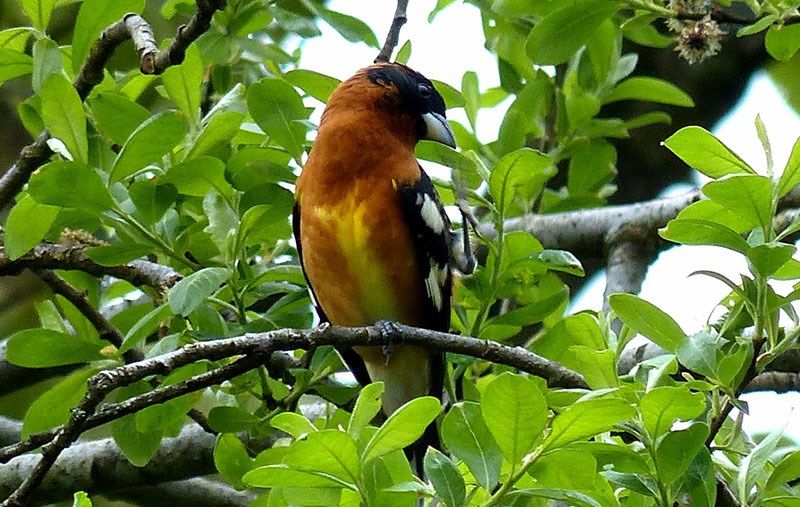Right now, unknown to most people, there is a nightly invasion taking place in our neighbourhoods.
Migratory birds are arriving from their wintering territories in the far south. Some of these birds winter in distant South America while others find suitable habitat in Central America. Some, like many Canadian citizens, may migrate only as far south as Arizona or New Mexico during the winter months.
Regardless of their winter destinations, these birds fly north each spring under cover of darkness, when fewer predators roam the skies. Each morning, exhausted and hungry, they must find a safe place to rest and will be unable to resume their migration until they find sufficient food to refuel. For some of these birds, the Lower Mainland will be their final destination.
This annual northward migration of billions of birds has actually been going on for more than a month. For example, rufous hummingbirds started to arrive in early April. First, the males came to establish their territories and then the females arrived. Right now, my hummingbird feeder requires replenishment every second day. Although I am not sure how many hummers are feeding from it, there is constant activity around it.
I expect black-headed grosbeaks to arrive any day now. These birds enjoy a snack of seeds, insects or small fruits, and are one the more colourful migratory birds that seem to be quite at home in suburban neighbourhoods.
So far, the warm sunny weather this spring appears to bode well for our birds. Many migratory birds are insect-eaters. When wet, cold weather accompanies spring, insects are far less abundant, resulting in a dire food shortage which can lead to nesting failures.
The boreal forests of North America provide significant nesting habitat for many species of birds, especially rare warblers such as the Cape May, bay-breasted, Connecticut and Tennessee warblers.
As you might guess from their names, these birds migrate north along the eastern coast, then take a left turn and spread out over the boreal forests to nest as far west as B.C. This year, with extensive fires in these forests, many of these birds are likely to have trouble finding suitable and safe nesting habitat.
A study carried out in 2012 showed significant declines in some bird populations — most especially among the migratory birds that catch insects on the wing. When we first moved to Port Moody in the early 1990s, swallows were a common sight in our neighbourhood. Now, it has been well over a decade since I have seen a swallow swooping over our streets in search of insects. Nonetheless, swallows can still be seen in places that offer outstanding habitat for them — places like Colony Farm Regional Park and DeBoville Slough.
Exactly what is causing declines in songbird populations is far from clear. Certainly, the loss of wintering habitat is partly to blame. We can help to provide winter habitat by drinking shade-grown organic coffee from Central and South America. Such coffee is grown on plantations with tall shade trees that provide important wintering areas for these birds. Consuming organic food crops not only creates safer working conditions for farmers but also helps to ensure the insects eaten by many birds do not turn out to be a toxic bite.
Birds need safe places to rest and feed each day during migration, so supporting the protection of parks across North America also helps migratory birds.
Using re-cycled paper products such as toilet paper also helps to ensure more forests remain in North America.
Avoiding the use of pesticides and planting wildlife-friendly flowers and shrubs in your yard also helps migratory birds.
One of my favourite wildlife shrubs is the red elderberry. Its berries ripen just when many birds are busy feeding their young. In my yard, I expect to see band-tailed pigeons and even the occasional woodpecker show up to feast on these small red berries.
--Elaine Golds is a Port Moody environmentalist who is president and conservation chair of the Burke Mountain Naturalists, and member of the boards of the Colony Farm Park Association and the Port Moody Ecological Society.
••••••••
FOR THE BIRDS
This weekend is International Migratory Bird Day, which always falls on the second Saturday in May.
The city of Vancouver has turned this event into a Migratory Bird Week, with events scheduled over several days. Locally, the Colony Farm Park Association is hosting an event on Saturday, May 14 from 1 to 4 pm. This year, the event coincides with the 20th anniversary of historic Colony Farm being transferred to Metro Vancouver as a new regional park.
The event will start at 1 p.m., with a short heritage tour of Colony Farm followed by birthday cake at 2 pm. A birding tour led by an experienced naturalist will start at 2:30 p.m.
The level route for this 90-minute birding walk is suitable for all ages. There will be also be displays available and children will have an opportunity to plant seeds to take home, do wildlife puzzles and other activities. Everyone is welcome to attend.



